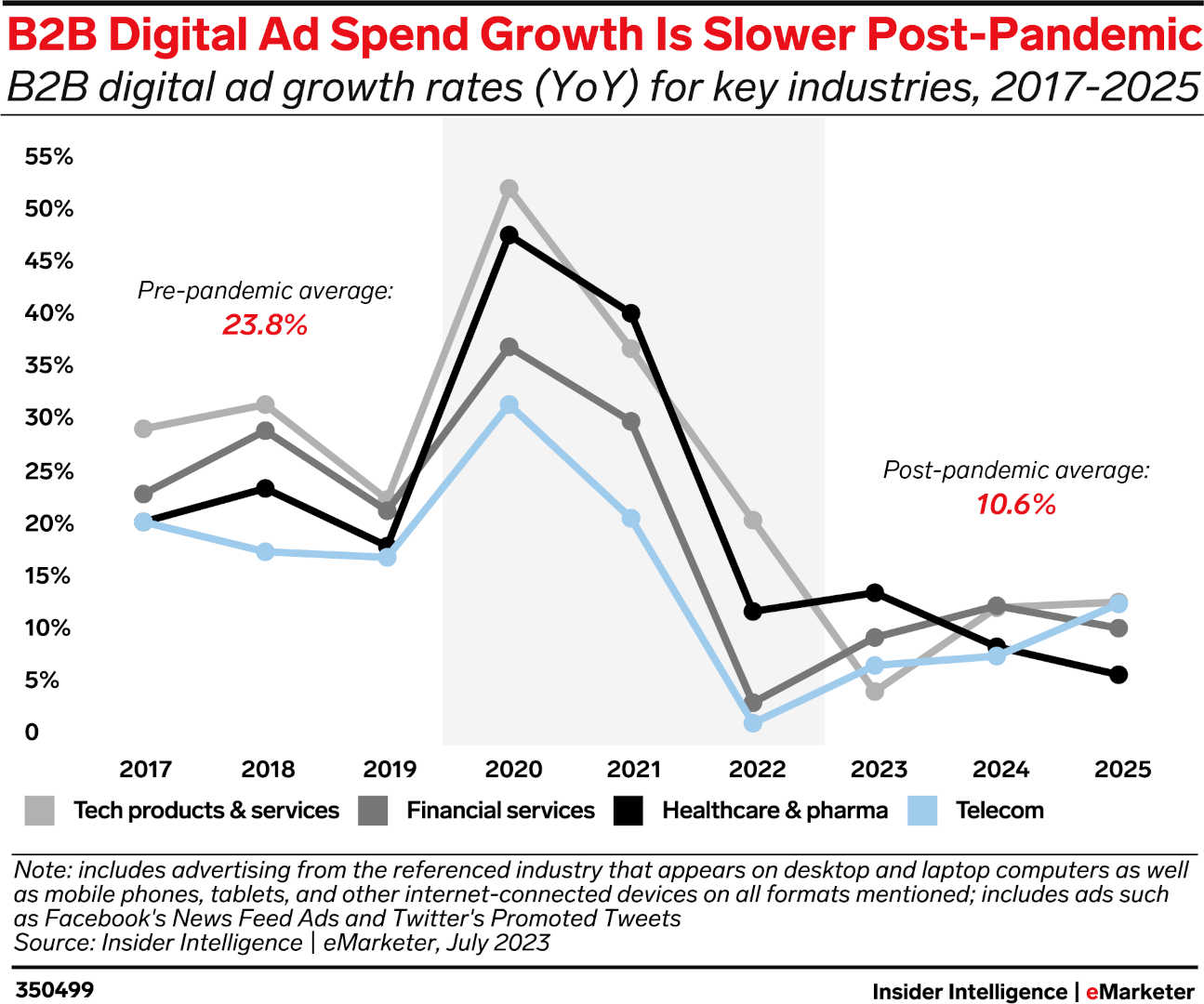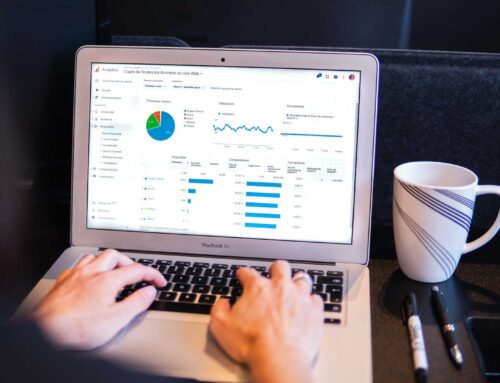B2B buyers don’t want to talk to salespeople anymore. Paid B2B ad spend is way down.
These two converging trends create a window of opportunity to increase sales and market share via B2B paid ads.
What does optimizing the customer journey with paid ads have to do with these trends?
Two converging trends create a window of opportunity to increase sales and market share via B2B paid ads. Share on XThe first trend is that B2B buyers now prefer a self-serve, DIY approach to buying. Gartner’s 2023 research shows that by 2025, a whopping 80% of B2B sales transactions will occur through online platforms.
Not only that, 33% of all buyers prefer a sales experience without a seller, with 44% of millennials being the most allergic to interacting with salespeople.
The second trend is that B2B spending on paid ads has dropped considerably since pre-pandemic levels, and the recovery is uneven. This drop may signal that companies are still grappling with recovery and resetting strategies. Their hesitation means a window of opportunity for proactive fast movers to grab market share.

How can you capitalize on these trends?
One idea is to drive paid traffic to a customer journey optimized for what customers want – frictionless digital interactions, especially on mobile devices.
A place to start is by optimizing the B2B customer journey with paid ads to capitalize on buyers’ preference for using digital channels. At the same time, competitors in your industry may be waffling on paid ad strategy.
This post will guide you through the key strategies for using paid ads to optimize your B2B customer journey.
When to Consider Paid Ads for B2B
In the B2B customer journey, timing is everything. Paid ads can be beneficial at various stages and critical touchpoints in the customer journey, but the key is understanding the customer’s journey and their stages—Awareness, Consideration, and Decision— so you can pinpoint when to deploy paid advertising for maximum impact.
Awareness Stage: Getting on the Radar
At the awareness stage, potential customers recognize that they have a problem that needs solving but may not know the available solutions yet. This stage is an excellent time to use paid ads to create brand visibility.
Examples of content: Blog posts, videos, or infographics can attract prospects and introduce them to your brand.
Consideration Stage: Nurturing Leads
During the consideration stage, prospects actively seek solutions and evaluate options. They are reading reviews, comparing features, and asking their network for opinions.
Examples of content: Paid ads at this stage can drive traffic to more detailed content like webinars, whitepapers, or case studies that position your product or service as the solution to their problem.
Remember that you can use retargeting strategies to keep your brand top of mind with prospects at this stage.
Decision Stage: Encouraging Conversions
At this point, prospects are ready to make a decision. They’ve done their research and are leaning towards a solution. The goal of paid ads here is to get the prospect to take that final step.
Types of content matter. Paid ads should lead to landing pages with apparent calls to action, leading them to convert—whether purchasing, signing up for a service, or contacting your sales team. Consider running tests with promotions, discounts, or exclusive features to lure them to the close.
Ongoing Relationship: Upselling and Cross-Selling
Even after a sale, the customer journey is still ongoing. Existing customers can be even more lucrative than new prospects. Target paid ads to upsell or cross-sell additional products or services or introduce new features that benefit the customer to increase the lifetime value and retain customers for the long term.
By understanding when to leverage paid ads at various customer journey stages, B2B companies can make smarter advertising decisions that yield better results. But the buyer stage is only one part of the puzzle. You need to consider segmenting the audience, too.
Audience Segmentation and Targeting in Paid Ads
Audience segmentation and targeting are crucial for the success of any paid advertising campaign, especially in a B2B context where the decision-making process is often more complex.
Below is a more in-depth exploration of how to implement these strategies for your paid ads.
Understand Your Audience’s Pain Points and Goals
Before you start any campaign, review your understanding of the audience’s needs, pain points, and objectives. A deep understanding informs your segmentation strategy and helps you tailor your ads to resonate with each group. In a B2B setting, consider variables like industry, company size, and job roles as basic segmentation criteria.
Types of Segmentation in Paid B2B Advertising
Generally speaking, the more specific your segment, the better your ad results. If you haven’t revisited your customer personas in a few months, it’s a good idea to review and optimize them for the persona in the context of the ad campaign. Other things you can consider are:
- Firmographic: Business entity characteristics, for example, industry, company size, and revenue
- Technographic: Technology stacks used by the company
- Demographic: For example, age, gender, education
- Geographic: Location-based targeting
- Psychographic: Interests, opinions, and lifestyle
- Behavioral: Previous interactions with your website or app or purchasing behavior
Remember that as you test your ads, the successful ads can also be a feedback loop, giving you more accurate information about your personas.
Tailoring Creative and Messaging
Once you’ve segmented your audience, tailor your ad creative to each group’s unique needs and challenges. For example, a healthcare SaaS company could target hospital administrators with ads focusing on operational efficiency while targeting physicians with messages about patient care and workflow.
A/B Testing B2B Ads for Continuous Refinement
A/B testing allows you to test different versions of your ads to see which performs best for each segment. You can try anything from headlines and calls to action to images and overall layout.
Remarketing and Retargeting Ads in B2B
These strategies involve showing ads to people who have previously interacted with your brand. In B2B, retargeting can be incredibly practical to stay top-of-mind during a long sales cycle.
Implementing Multi-Channel Marketing
Implementing a multi-channel marketing strategy involves deploying your advertising and content across multiple platforms to engage your audience wherever they are. The key to success lies in maintaining a consistent brand message while tailoring the delivery format to suit each channel’s unique characteristics.
Whether using search engines, social media, or email, the goal is coordinating efforts to provide a seamless customer journey. Leveraging data analytics is crucial; it allows you to monitor performance across channels and refine your approach for better ROI.
By embracing a multi-channel strategy, B2B businesses can increase touchpoints, enhance customer engagement, and drive more conversions.
Conversion-Driven Landing Pages
Conversion-driven landing pages are the crucial link between your paid ads and the desired action you want the visitor to take, whether signing up for a webinar, purchasing, or contacting sales. These landing pages should offer a seamless experience that aligns with the messaging and visuals of the ads that led the user there.
Elements like compelling headlines, concise copy, and clear calls to action are essential. Utilizing A/B testing can help you refine these elements for optimal performance. You can also consider dynamic landing pages, where the system uses different landing pages based on a visitor’s journey.
In the B2B context, where sales cycles can be lengthy and complex, a well-crafted landing page can be a powerful lever for business growth, effectively turning prospects into customers.
Moving Ahead
Even with more automation and AI-driven data integration tools, B2B marketing complexity is increasing. Coordinating paid ads, audience segmentation, and conversion-driven landing pages can seem overwhelming.
While it may seem daunting, you don’t have to go it alone. FunnelEnvy can help you set up a system to track and test results at every stage of the customer journey. We work with clients in many industries, from consumer healthcare to industrial equipment. We provide customized assistance to our clients with all elements of their landing page design, from technical aspects like page speed and caching to form fields and CTA design.
Are you interested in finding out more? Just click here to complete a short quiz that we’ve created to help us learn more about your needs and how we may be able to help.







